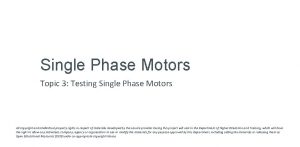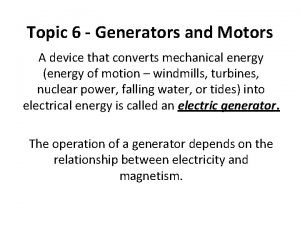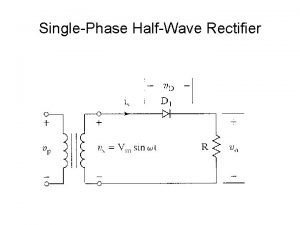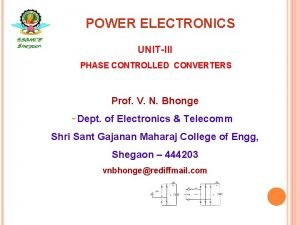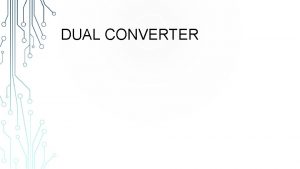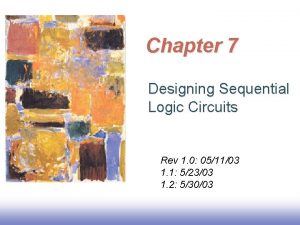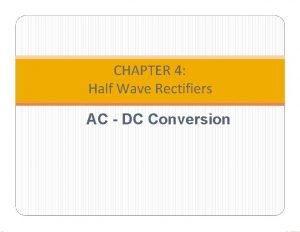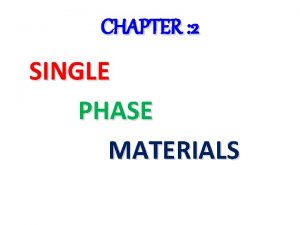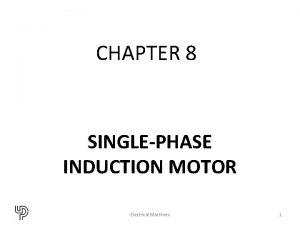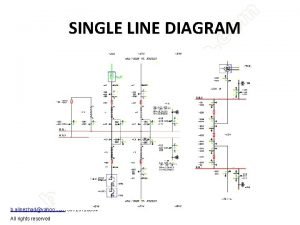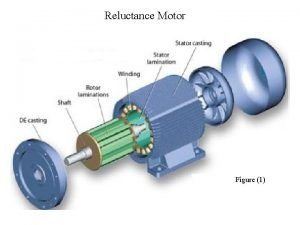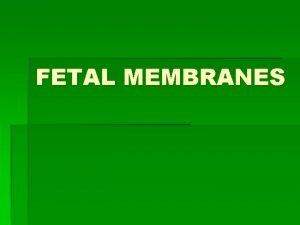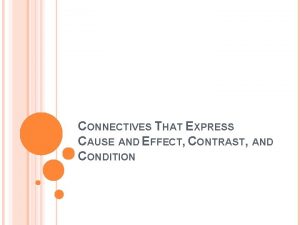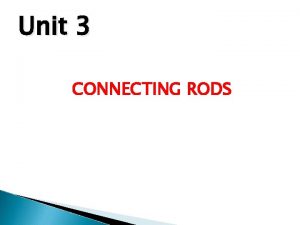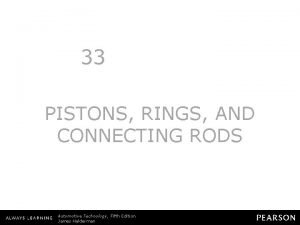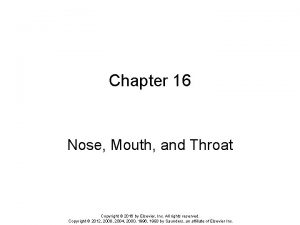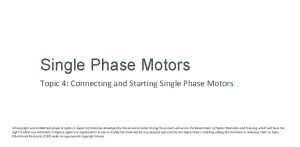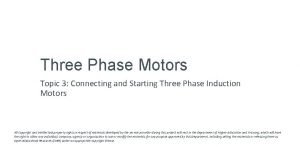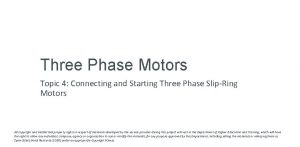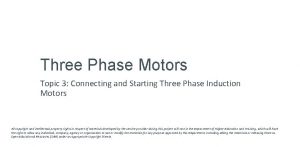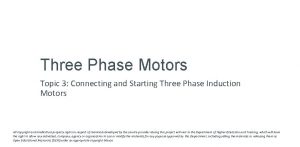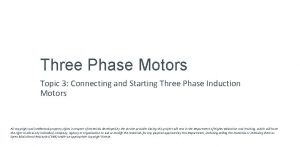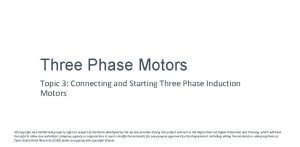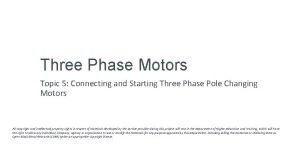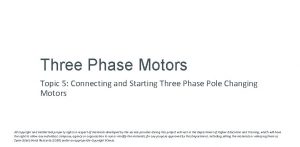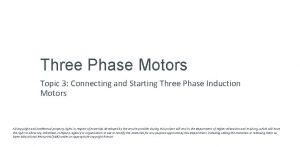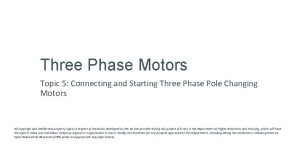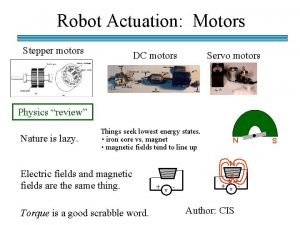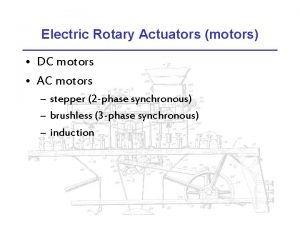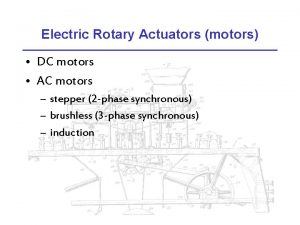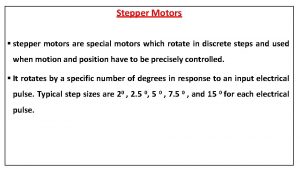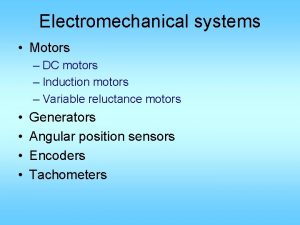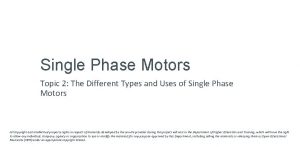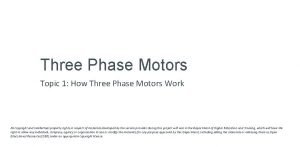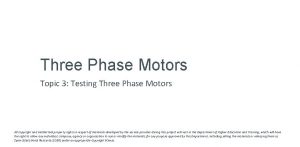Single Phase Motors Topic 4 Connecting and Starting




































- Slides: 36

Single Phase Motors Topic 4: Connecting and Starting Single Phase Motors All copyright and intellectual property rights in respect of materials developed by the service provider during this project will vest in the Department of Higher Education and Training, which will have the right to allow any individual, company, agency or organisation to use or modify the materials for any purpose approved by this Department, including selling the materials or releasing them as Open Educational Resources (OER) under an appropriate copyright license.

Assumed prior learning 05_01_00 05_01_02 05_02_01 05_03_01

Outcomes By the end of this unit the learner will be able to: 1. Correctly test a motor through the terminal box to establish the live, neutral and terminal studs and the bridge pieces that may be required. 2. Correctly connect the motor to the power supply by means of a flexible cord, a 16 A plug top and a compression gland. 3. Correctly test the circuit and run the motor.

Unit 4. 1: Connecting a Single Phase Motor to a Power Supply

Introduction In this unit we are going to supply using flexible cable. connect a single phase motor directly to a single phase power supply using flexible cable. With this crucial knowledge, you will be ready to wire single phase motors to different kinds of starting buttons and switches.

Safety first When you work with motors you must put your safety and the safety of others first. You must complete the necessary Hazard Identification and Control (HIAC) Form. Need help with HIACs? Click the button to go to Topic X in The World of an Electrician Get help with HIAC Forms

Potential Hazards Here are some general potential hazards you should look out for: Vehicles, traffic or mobile Working at heights above equipment 2 m Hazardous Materials or Waste Lifting and material handling Electricity, machinery, stored energy or machine isolation Work with Oxy-fuel gas mixtures

Stop and Check? Because there are some potential hazards associated with this job, you need to check that all the necessary safety controls related to these hazards are in place. If you are not sure what these safety controls are, you should stop this unit and refer back to Topic X in The World of an Electrician before continuing. Learn about Safety Controls

Before We Begin Before you do any electrical tests, you must make sure that you have isolated and locked out the supply to the motor. Make sure you know how to do this by referring to Topic X in The World of An Electrician. Learn about Isolating and Lock-Out Procedures

The Main Steps There are 4 main steps involved in connecting a single phase motor to a single phase power supply via a flexible cable. Step 1: Draw the circuit diagram Step 2: Prepare the cable Step 3: Wire the motor Step 4: Test

Step 1: Draw the Circuit Diagram The first thing we have to do is make sure we understand how the motor we are connecting is wired internally and draw a circuit diagram of the motor showing how the terminal studs in the terminal box relate to the diagram. For this, we are going to do continuity tests like we did in the Electrical Tests unit in Topic 2 of this course. Be reminded how to do continuity tests Learn how to draw the motor circuit diagram

Practice Drawing Circuit Diagrams Look at the results of some other continuity tests performed on a single phase motor with this terminal block. Now draw the corresponding terminal block and circuit diagrams. Make sure that you include the terminal stud locations on your circuit diagram and indicate how to achieve clockwise and anti-clockwise rotations. Img 05 See the test results

Test Values B 1 – C 2: None B 1 – B 2: None B 1 – A 1: None B 1 – C 1: 0, 2Ω B 1 – A 2: None C 2 – B 2: 16, 9Ω C 2 – A 1: None C 2 – C 1: None C 2 – A 2: None B 2 – A 1: None B 2 – C 1: None B 2 – A 2: None A 1 – C 1: None A 1 – A 2: 8, 2Ω C 1 – A 2: None

Upload Your Circuit Diagram Once you have drawn your circuit diagram take a picture of it and upload it. Choose image Upload

Practice Drawing Circuit Diagrams This is what your diagram should have looked like. Click the image to see a full screen version. Img 06

Practice Drawing Circuit Diagrams Now draw the corresponding motor circuit diagram for this completed block diagram Img 07

Step 2: Prepare the Cable The first thing you need to make sure of is that you have the correct size cable. Using the wrong size cable can lead to it overheating and causing damage. It can also be a fire hazard! To choose the correct cable, we need to consider the current that it will need to carry and then use current rating tables to select the right cable for the job. Have a look at the motor nameplate to see the motor’s current rating. View the motor nameplate

What is the Current Rating? Enter the current rating into the text box below. Submit Current Rating View the motor nameplate again

Read a Current Rating Table? Now that we know the current our cable must carry, we can select the right one. To do this we need a current rating table for flexible cables. View the current rating table and choose, then enter the best cable diameter in the text box below. Required cable View the current rating table mm 2 Submit Learn how to read current rating tables

The 16 A Plug Now that we have chosen the right size cable, we need to fit a standard 16 A plug to one end. We learnt how to fit a plug in Topic 1 of Course 3: Electrical Components and Systems. If you are unsure how to connect a plug, refer back to this topic now. Learn how to fit a 16 A plug Img 10

Fit the Plug Drag the correct cable to each terminal of the plug to fit the plug.

Compression Glands We need to prepare the connection of the other end of our wire to the motor. For this, we need a compression gland. We also covered compression glands in Topic 1 of Course 3: Electrical Components and Systems. If you need a reminder about what compression glands are, why they are used and how to choose the right size, go back to this topic now. Learn about compression glands Img 13

Choose the Right Compression Gland Below is a link to a compress gland selection table. Remember that the cable we chose had a diameter of 14 mm 2. Choose the right compression gland for this cable and enter the gland number in the field below. Gland No. Open the compression gland selection table Submit

Step 3: Wire the Motor Before you wire the motor, you need to prepare the other end of the cable, terminating the wires with the necessary lugs, and fit the compression gland. If you need help with any of this, you should refer back to Topic 1 in Course 3: Electrical Components and Systems. Learn about compression glands and lugs Img 15 Learn about terminating cables

Connect the Motor Refer back to your circuit diagram indicating to which terminals the live and neutral wires should be connected and then drag the wires below to the right terminals. E W 2 U 1 U 2 V 1 V 2 W 1

Down to Earth It is very important that you earth the motor correctly. Not doing so can lead to the damaged equipment or electrocution. Look for the earth connection. It is usually in the terminal box and grounds the motor through the motor frame.

Step 4: Test With everything connected, it is time to test. 1. Make sure connections are to the right studs. 2. Make sure all the bolts are tight. 3. Make sure motor is correctly earthed.

Video Briefing – Vid 01 (1 of 2) Video of an electrician demonstrating the following: 1. Open the terminal box 2. Look for a wiring diagram 3. Draw the terminal block diagram 4. Use continuity tests to determine C/S, RW and SW 5. Add these results to the terminal block diagram 6. Draw a schematic diagram of the motor with SW, RW, C/S and Cap and note position of terminals on schematic (see next slide) 7. From this diagram determine supply position – usually supply is connected to RW terminals. As AC, orientation does not matter. 8. Note any bridging needed forward and reverse directions

Video Briefing – Vid 01 (2 of 2) C/S – 0, 2Ω W 2 U 2 Cap L V 2 U 1 SW – 13, 2Ω U 1 V 1 RW – 6, 4Ω W 2 Clockwise U 2 RW SW W 1 N C/S – 0, 2Ω U 2 Cap V 2 SW – 13, 2Ω U 1 V 2 W 2 V 1 W 1 V 1 Anti-Clockwise W 1 W 2 U 2 Cap V 2 SW – 13, 2Ω U 1 V 1 W 1

Image Briefing – Img 05 B 1 A 1 C 2 C 1 B 2 A 2

Image Briefing – Img 05 C 1 C 2 L A 1 A 2 RW B 2 Clockwise SW B 1 N C/S – 0, 2Ω C 1 C 2 A 1 SW – 16, 9Ω RW – 8, 2Ω Cap B 2 C 1 B 1 C 2 A 2 A 1 C 1 B 2 Anti-Clockwise B 2 C 2 A 1 B 1

Image Briefing – Img 05 Block diagram based on this image.

Image Briefing – Img 08 Single phase motor nameplate like this one. Final image will depend on the motor used in vid 01.

Image Briefing – Img 09 Flexible cable current rating table

Image Briefing – Img 11 BRown to Right-hand pin BLue to Left-hand pin

Image Briefing – Img 17 E W 2 U 1 U 2 V 1 V 2 W 1
 How everything
How everything Waiting line management
Waiting line management Topic 6 - generators and motors worksheet answers
Topic 6 - generators and motors worksheet answers Ac systems lesson 4
Ac systems lesson 4 Clincher examples
Clincher examples Narrow down the topic
Narrow down the topic Mobile phase and stationary phase
Mobile phase and stationary phase Column chromatography images
Column chromatography images Which detector used in hplc
Which detector used in hplc Normal phase vs reverse phase chromatography
Normal phase vs reverse phase chromatography Tswett pronunciation
Tswett pronunciation Normal phase vs reverse phase chromatography
Normal phase vs reverse phase chromatography Difference between phase voltage and line voltage
Difference between phase voltage and line voltage Phase to phase voltage
Phase to phase voltage Csce 441
Csce 441 Contoh wilayah single topic region
Contoh wilayah single topic region Contoh multiple topic region
Contoh multiple topic region Half wave rectifier battery charger
Half wave rectifier battery charger 3 phase full converter
3 phase full converter Types of gels
Types of gels Single phase dual converter waveform
Single phase dual converter waveform C2mos master-slave positive edge-triggered register
C2mos master-slave positive edge-triggered register Controlled full wave rectifier with rl load
Controlled full wave rectifier with rl load Material selection diagram
Material selection diagram Types of ac voltage controller
Types of ac voltage controller Single phase induction motor
Single phase induction motor Yahoo
Yahoo Motor figure
Motor figure Von neumann architecture is sisd
Von neumann architecture is sisd Single instruction single data
Single instruction single data Connecting stalk
Connecting stalk Connecting rod diagram
Connecting rod diagram Therefore cause and effect
Therefore cause and effect Function of the connecting rod
Function of the connecting rod Connecting a verbal description to table and graph
Connecting a verbal description to table and graph Pistons rings and connecting rods
Pistons rings and connecting rods The cleft connecting the nose and mouth to the larynx
The cleft connecting the nose and mouth to the larynx
